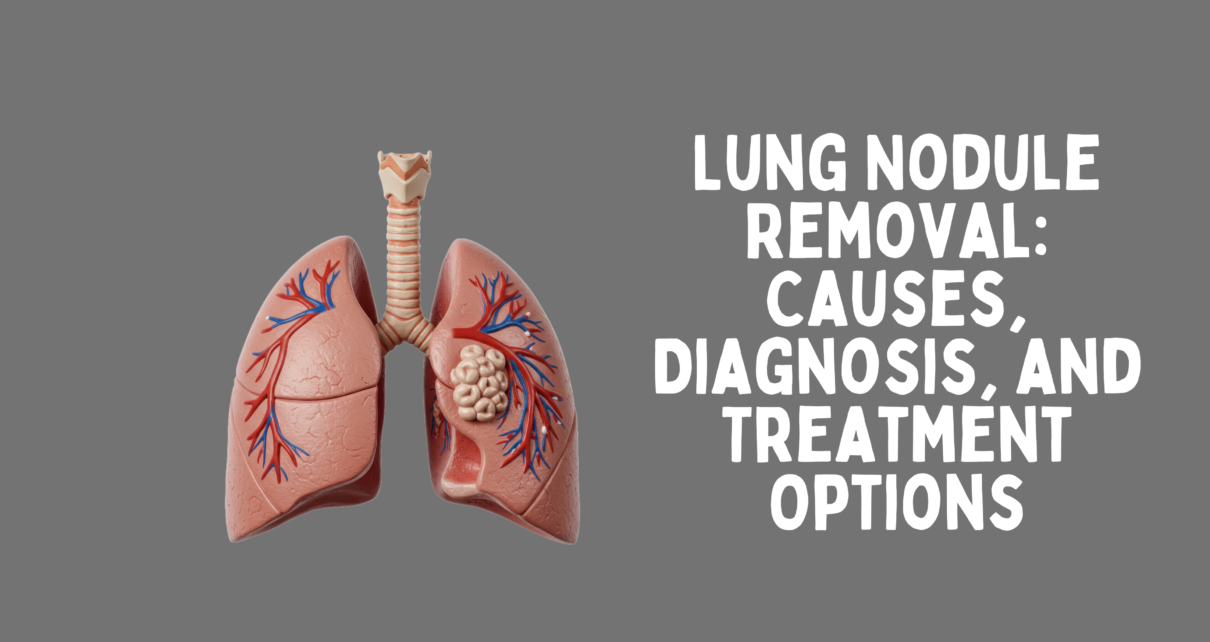Lung health plays a crucial role in our overall well-being, and any abnormality in the lungs can cause anxiety. One of the most commonly detected abnormalities today is a lung nodule. Thanks to advancements in imaging technologies like CT scans, lung nodules are often found incidentally when patients undergo chest imaging for unrelated reasons. While most lung nodules are benign (non-cancerous), some may require closer evaluation and lung nodules treatment, including removal, to rule out or manage lung cancer.
What is a Lung Nodule?
A lung nodule, sometimes called a pulmonary nodule or “spot on the lung,” is a small, round or oval growth in the lung. Nodules are usually less than 3 cm in size. If larger, they are classified as a lung mass, which has a higher chance of being cancerous.
Lung nodules are fairly common. Studies suggest that about 1 in 4 chest CT scans detect at least one lung nodule. The good news is that the majority of these are benign, caused by infections, old scars, or non-cancerous growths. However, in certain cases, especially in people with risk factors like smoking, family history of lung cancer, or advanced age, a lung nodule may indicate lung cancer.
Causes of Lung Nodules
Lung nodules can form due to a variety of reasons. The most common causes include:
- Infections
- Tuberculosis (TB)
- Fungal infections (like histoplasmosis or aspergillosis)
- Bacterial pneumonia leaving behind scars
- Tuberculosis (TB)
- Inflammatory Conditions
- Rheumatoid arthritis
- Sarcoidosis
- Granulomatous diseases
- Rheumatoid arthritis
- Benign Tumors
- Hamartomas are non-cancerous growths that may appear as nodules.
- Hamartomas are non-cancerous growths that may appear as nodules.
- Malignant Tumors
- Primary lung cancer
- Metastatic cancer (spread from other body sites like breast, kidney, or colon)
- Primary lung cancer
Symptoms of Lung Nodules
Most lung nodules do not cause noticeable symptoms and are often discovered incidentally. However, in some cases, patients may experience:
- Persistent cough
- Coughing up blood (hemoptysis)
- Shortness of breath
- Chest pain
- Unexplained weight loss
- Fatigue
If a lung nodule grows over time or causes symptoms, further evaluation and treatment may be required.
How Are Lung Nodules Diagnosed?
The diagnosis of a lung nodule typically begins with imaging tests:
- Chest X-ray – May reveal a shadow or abnormal spot.
- CT Scan of the Chest – Provides a clearer picture of the size, shape, and location of the nodule.
- PET Scan – Helps determine if the nodule is metabolically active, often indicating cancer.
If imaging raises suspicion, a tissue sample may be needed for confirmation:
- Bronchoscopy – A thin tube is inserted into the lungs to collect tissue.
- Needle Biopsy – A needle is guided through the chest wall into the nodule.
- Surgical Biopsy – Sometimes necessary if less invasive methods are inconclusive.
When is Lung Nodule Removal Necessary?
Not all lung nodules require removal. Many small, benign nodules are monitored over time with serial CT scans to ensure they do not grow or change. However, removal is recommended when:
- The nodule is larger than 8–10 mm.
- The nodule shows growth over time on follow-up scans.
- The patient has risk factors like smoking history or family history of cancer.
- The nodule is PET scan positive (suggesting malignancy).
- The nodule causes symptoms such as coughing blood or chest pain.
Surgical Options for Lung Nodule Removal
Advances in thoracic surgery have made lung nodule removal safer and less invasive. The choice of surgery depends on the size, location, and nature of the nodule.
1. Video-Assisted Thoracoscopic Surgery (VATS)
- A minimally invasive technique using small incisions and a camera.
- Allows removal of nodules with less pain and faster recovery compared to open surgery.
- Often used for diagnostic biopsies and small tumor removals.
2. Robotic-Assisted Thoracic Surgery
- An advanced form of minimally invasive surgery where the surgeon uses robotic instruments for greater precision.
- Provides excellent visualization and accuracy, especially for complex cases.
3. Thoracotomy (Open Surgery)
- Traditional approach involving a larger incision to access the lung.
- Used when nodules are deep-seated, large, or difficult to reach with minimally invasive techniques.
4. Types of Resection Depending on Nodule Size/Location:
- Wedge Resection – Small portion of the lung removed along with the nodule.
- Segmentectomy – A larger portion of lung (one segment) is removed.
- Lobectomy – Entire lobe of the lung removed if the nodule is confirmed cancerous.
Recovery After Lung Nodule Removal
Recovery depends on the type of surgery performed:
- Hospital Stay: Usually 2–5 days for minimally invasive surgery, longer for open thoracotomy.
- Pain Management: Pain is controlled with medications; discomfort decreases over time.
- Breathing Exercises: Patients are encouraged to use incentive spirometry to expand the lungs and prevent complications.
- Return to Normal Activity: Most patients resume daily activities within 3–6 weeks, depending on recovery speed.
Risks and Complications
Like all surgical procedures, lung nodule removal carries certain risks, including:
- Bleeding
- Infection
- Air leaks from the lung
- Pneumonia
- Blood clots
- Rarely, reduced lung function
However, with skilled thoracic surgeons and advanced techniques, the risks are minimized, and outcomes are generally very favorable.
Alternatives to Surgery
In some cases, surgery may not be the best option, especially for patients with poor lung function or multiple health issues. Alternatives include:
- Active Surveillance: Monitoring nodules with regular scans.
- Needle or Bronchoscopic Biopsy: To confirm diagnosis without full surgery.
- Stereotactic Body Radiotherapy (SBRT): Focused radiation for patients who cannot undergo surgery.
Outlook and Prognosis
The outcome of lung nodule removal depends largely on the cause.
- Benign Nodules: Once removed, no further treatment is usually required.
- Early-Stage Lung Cancer: Surgery can be curative if the cancer is detected early and has not spread.
- Metastatic Cancer: Prognosis depends on the primary cancer and overall health.
Early detection is key. Patients who undergo timely removal of malignant nodules often have significantly better long-term survival rates.
Final Thoughts
Finding a lung nodule can be alarming, but it is important to remember that most nodules are not cancerous. Careful monitoring, proper diagnosis, and timely surgical removal when necessary can ensure the best outcomes. With advancements in minimally invasive and robotic surgery, lung nodule removal is now safer, less painful, and associated with quicker recovery times than ever before.
If you or a loved one has been diagnosed with a lung nodule, consult a qualified thoracic surgeon for personalized advice. Early evaluation and treatment can make a life-saving difference.




